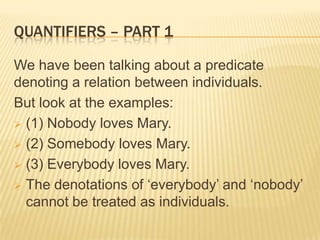Quantifiers (part 1)
- 1. Quantifiers – Part 1We have been talking about a predicate denoting a relation between individuals.But look at the examples:(1) Nobody loves Mary.
- 2. (2) Somebody loves Mary.
- 3. (3) Everybody loves Mary.
- 4. The denotations of ‘everybody’ and ‘nobody’ cannot be treated as individuals.Quantifiers (1)Words like ‘all’, ‘some’ and ‘none’ are called quantifiers.Previously, we said that hyponym relations are defined in terms of superordinate and co-hyponyms.If duck is a hyponym ofbird then the set of ducks is a subset of the set of birds.Also, an antonym relation was represented by disjoint sets (smoker vs. non-smoker)
- 5. Quantifiers (1)Something similar applies when studying quantifiers.The previous lexical relations could be expressed as ‘all ducks are birds’ and ‘no smokers are non-smokers’Because these are lexical relations, they don’t make very informative statements about the world.
- 6. QUANTIFIERSA more interesting claim is‘all Australians are sportspeople’They are not statements about the meaning of words but claims about the situation in the world.However, they are like the lexical relations in claiming a particular relation between two sets.
- 7. QUANTIFIERSThe first step is to treat quantifiers as denoting a relation between two sets.‘All’ denotes the subset relation between two sets.
- 8. Some Australians are sportspeople. Australians Sportspeople
- 9. quantifiersNo Australians are sportspeople. Australians Sportspeople
- 10. SummaryPredicates:Denote relations between individuals
- 11. Lexical relations don’t make very informative statements about the world.Quantifiers:Like lexical relations claiming a relation between two sets.
- 12. Not statements about the meaning of words but claims about the situation in the world.







